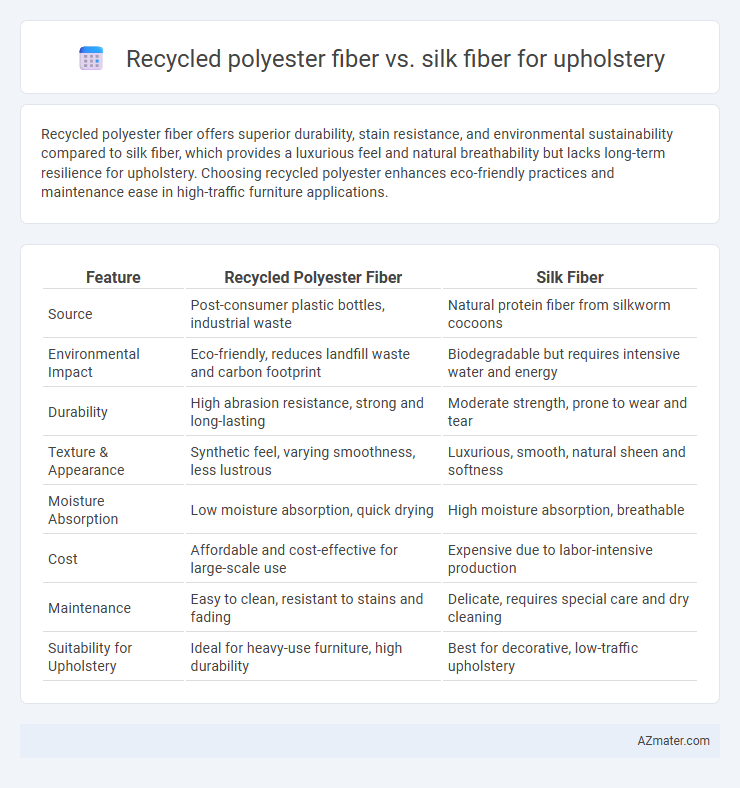Recycled polyester fiber offers superior durability, stain resistance, and environmental sustainability compared to silk fiber, which provides a luxurious feel and natural breathability but lacks long-term resilience for upholstery. Choosing recycled polyester enhances eco-friendly practices and maintenance ease in high-traffic furniture applications.
Table of Comparison
| Feature | Recycled Polyester Fiber | Silk Fiber |
|---|---|---|
| Source | Post-consumer plastic bottles, industrial waste | Natural protein fiber from silkworm cocoons |
| Environmental Impact | Eco-friendly, reduces landfill waste and carbon footprint | Biodegradable but requires intensive water and energy |
| Durability | High abrasion resistance, strong and long-lasting | Moderate strength, prone to wear and tear |
| Texture & Appearance | Synthetic feel, varying smoothness, less lustrous | Luxurious, smooth, natural sheen and softness |
| Moisture Absorption | Low moisture absorption, quick drying | High moisture absorption, breathable |
| Cost | Affordable and cost-effective for large-scale use | Expensive due to labor-intensive production |
| Maintenance | Easy to clean, resistant to stains and fading | Delicate, requires special care and dry cleaning |
| Suitability for Upholstery | Ideal for heavy-use furniture, high durability | Best for decorative, low-traffic upholstery |
Introduction: Comparing Recycled Polyester Fiber and Silk Fiber
Recycled polyester fiber offers durability, stain resistance, and eco-friendly credentials, making it ideal for high-traffic upholstery applications. Silk fiber provides a luxurious texture and natural sheen with excellent breathability but requires careful maintenance and is less resistant to abrasion. Comparing these fibers highlights the trade-offs between sustainability and luxury in upholstery fabric choices.
Sustainability and Environmental Impact
Recycled polyester fiber for upholstery significantly reduces waste by repurposing plastic bottles and minimizes reliance on virgin petroleum resources, leading to lower carbon emissions compared to virgin polyester production. Silk fiber, while biodegradable and naturally sourced, involves resource-intensive sericulture practices that consume substantial water and energy, raising concerns about its overall environmental footprint. Choosing recycled polyester enhances circular economy benefits and reduces landfill waste, making it a more sustainable option for eco-conscious upholstery projects.
Source and Manufacturing Processes
Recycled polyester fiber is derived from post-consumer plastic bottles or textile waste, undergoing melting and extrusion to create durable yarns suitable for upholstery fabric. Silk fiber is produced from the natural protein fiber spun by silkworms, requiring labor-intensive harvesting and processing of cocoons to extract long, fine filaments. The manufacturing of recycled polyester prioritizes sustainability and waste reduction, while silk production depends on traditional sericulture practices with a higher environmental footprint.
Durability and Longevity in Upholstery Uses
Recycled polyester fiber offers exceptional durability and resistance to abrasion, making it highly suitable for upholstery subjected to heavy use and frequent cleaning. In contrast, silk fiber, while luxurious and soft, lacks the strength and abrasion resistance needed for long-term durability in upholstery applications. The longevity of recycled polyester upholstery significantly outperforms silk, maintaining structural integrity and appearance over extended periods under constant wear.
Comfort and Texture Differences
Recycled polyester fiber offers a durable and cost-effective option for upholstery with a smooth, synthetic texture that resists wrinkles and stains but lacks the natural softness found in silk fiber. Silk fiber provides a luxurious, breathable, and hypoallergenic surface with a soft, lustrous feel that enhances comfort, though it requires more delicate care and is less resistant to abrasion. Choosing between recycled polyester and silk fiber depends on balancing the need for durability and low maintenance with the desire for premium comfort and texture in upholstery applications.
Aesthetic Appeal and Color Retention
Recycled polyester fiber offers vibrant color retention and resists fading over time, making it ideal for upholstery with long-lasting aesthetic appeal. Silk fiber, prized for its natural sheen and luxurious texture, provides a sophisticated and elegant look but is more prone to color fading when exposed to sunlight. Upholstery selections balancing durability and appearance often favor recycled polyester for its superior colorfastness and maintenance ease.
Maintenance and Cleaning Requirements
Recycled polyester fiber offers low maintenance and easy cleaning, as it resists stains, moisture, and fading, making it ideal for high-traffic upholstery areas. Silk fiber requires delicate care, including professional cleaning and protection from direct sunlight and moisture, to preserve its natural sheen and texture. Choosing recycled polyester reduces long-term upkeep costs and enhances durability compared to the more fragile and high-maintenance nature of silk upholstery.
Cost Comparison and Budget Considerations
Recycled polyester fiber offers a significantly lower cost for upholstery compared to silk fiber, making it an attractive option for budget-conscious projects. While silk fiber provides a luxurious feel and natural luster, its higher price per yard and maintenance expenses increase overall upholstery costs. Considering long-term durability and initial investment, recycled polyester fiber presents a cost-effective alternative without sacrificing essential performance.
Suitability for Various Upholstery Applications
Recycled polyester fiber offers high durability, stain resistance, and colorfastness, making it suitable for high-traffic upholstery in commercial and residential settings. Silk fiber provides a luxurious texture and natural sheen but is less durable and more prone to wear and staining, restricting its use mainly to low-traffic or decorative upholstery pieces. For upholstery applications requiring longevity and easy maintenance, recycled polyester is a more practical choice, whereas silk is preferred for aesthetic appeal in refined interior designs.
Conclusion: Choosing the Right Fiber for Upholstery
Recycled polyester fiber offers durability, stain resistance, and environmental benefits, making it ideal for high-traffic upholstery in eco-conscious settings. Silk fiber provides luxurious texture, natural sheen, and breathability but requires delicate care and is less durable under heavy use. Selecting between these fibers depends on balancing sustainability, maintenance, and the desired aesthetic for upholstery projects.

Infographic: Recycled polyester fiber vs Silk fiber for Upholstery
 azmater.com
azmater.com